Assap guide me on this question
Practice Problem #1 C Company manufactures a number of consumer items for general household use. During the recent month, the company manufactured 5,000 units using 12,000 pounds of material. The 14,000 pounds purchased cost the company $21,000. According to the standard cost card, each unit requires 2.2 pounds, at a cost of $1.40 per pound. Required: Compute the material price variance and material quantity variance. Practice Problem #2 N Company makes premium chocolate in Chicago. One of the company's products is the Bango Mint. Bango Mints are packed 24 per box. During June, 4,000 boxes were produced. The company paid its direct labor workers a total of $14,280 for their work or $11.90 per hour. According to the standard cost card for Bango Mints, each box should require 0.3 direct labor hours at a cost of $12.00 per hour. Required: Compute the labor price variance and a labor quantity variance. Practice Problem #3 ABC Company's overhead rate was based on estimates of $400,000 for overhead costs and 40,000 direct labor hours. ABC standards allow for 2 hours of direct labor per unit produced. Production in January was 1,800 units and actual overhead incurred in January was $39,000. The overhead budgeted for 3,600 standard direct labor hours is $35,200, of which $10,000 was fixed. Required: a) Compute variable overhead controllable spending variance. b) Compute the fixed overhead volume variance.6. Company's total labor variance is a) $770 U b) $800 U C) $1,030 F d) $1,930 F The next 2 questions refer to the following information. The actual and standard direct labor rates were $8.50 and $8.00, respectively. 5,500 direct labor-hours were normal capacity. The standard quantity of hours allowed for units produced was 5,000. The standard variable overhead per direct labor-hour is $5.00 and the fixed overhead rate is $6.00. 7. What is the controllable overhead variance if the variable manufacturing overhead costs were $24,750? a) $2,250 U b) $250 F c) $4,750 F d) $1,350 F 8. What is the overhead volume variance if the variable manufacturing overhead costs were $24,750? a) $2,000 U $2,500 F C) $3,000 U d) $3,500 F 9. Which of the following is not a benefit of using a balanced scorecard a) It creates linkages from high-level goals to lower level employees b) It provides measurable objectives that are not financial c) It integrates all of the company's goals d) It can easily access individual performance 10. Which of the following is not a benefit of using standard costing a) Useful in setting selling prices b)Used as a way to place blame on managers or employees c)Simplifies costing of inventory d) Contributes to management control1. The difference between the actual price and the standard price, multiplied by the actual quantity of materials purchased is the a) direct labor price variance b) direct labor quantity variance c) direct materials price variance d) direct materials quantity variance 2. J Company has a material standard of 1 pound per unit of output. Each pound has a standard price of $25 per pound. During July, J Company paid $127,250 for 4,950 pounds, which they used to produce 4,700 units. What is the direct material price variance? a) $3,500 unfavorable b) $2,600 favorable c) $12,600 unfavorable d) $10,000 unfavorable 3. G Company has a material standard of 1.1 pound per unit of output. Each pound has a standard price of $25 per pound. During July, G Company paid $118,800 for 5,100 pounds, which they used to produce 4,900 units. What is the direct materials quantity variance? a) $7,250 favorable b) $5,000 favorable c) $7,250 unfavorable d) $5,000 unfavorable The next 3 questions refer to the following information. A Company has a standard of 1 direct labor hour per unit at $12 per hour. 3,850 labor hours costing $46,970 were used to produce 4,000 units. 4. Company's labor price variance is a) $770 F b) $770 U C) $1,030 F d) $1,030 U . Company's labor quantity variance is a) $1,830 U b) $1,830 F C) $1,800 F d) $1,800 U









